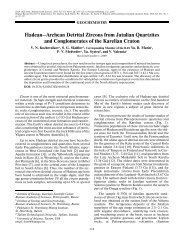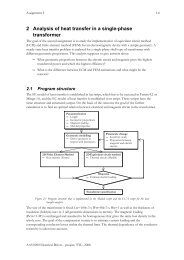power electronics and electrical drives - of / [www.ene.ttu.ee]
power electronics and electrical drives - of / [www.ene.ttu.ee]
power electronics and electrical drives - of / [www.ene.ttu.ee]
Create successful ePaper yourself
Turn your PDF publications into a flip-book with our unique Google optimized e-Paper software.
1.3. Historical development <strong>of</strong> <strong>power</strong> <strong>electronics</strong>On June 1, in 1921 F. W. Meyer, a German electrician, first formulated the main principles<strong>and</strong> development trends <strong>of</strong> <strong>power</strong> <strong>electronics</strong> [1]. This data could be considered as birthday <strong>of</strong><strong>power</strong> <strong>electronics</strong>. During prehistory <strong>of</strong> modern <strong>power</strong> <strong>electronics</strong>, first operation principles<strong>of</strong> <strong>power</strong> components were developed <strong>and</strong> the first experiments <strong>of</strong> their application werecarried out. Theories that form the basis <strong>of</strong> <strong>power</strong> <strong>electronics</strong> are known since the end <strong>of</strong> the19th century. In 1882 J. Jasmin (1818−1886), a French research physicist, found that mercuryelectric arc has a capability <strong>of</strong> conduct current only in one direction, <strong>and</strong> instead <strong>of</strong> amechanical switches, proposed to use this effect for rectifying alternating current. In 1892 L.Arons (1860−1919), a German physician, invented the first mercury arc vacuum valve. P.Cooper Hewitt (1861−1921), American electrician, developed the first mercury arc valve,with practical applications in 1901. A year later he patented the mercury arc rectifier. J. A.Fleming (1849−1945) invented the first vacuum diode in 1906. In the same year G. W.Pickard (1877−1950), an American electrician, invented the silicon valve. In 1907 L. deForest invented the vacuum triode. All these devices, with very low <strong>power</strong> switchingcapability, were unable to switch <strong>power</strong> circuits. However later, on the basis <strong>of</strong> the sameprinciples, many types <strong>of</strong> <strong>power</strong> switches were developed.In the first half <strong>of</strong> the 20th century, <strong>power</strong> converters <strong>of</strong> electric <strong>drives</strong> <strong>and</strong> other <strong>power</strong>equipment were mainly based on gas-discharge valves, thyratrons, mercury arc rectifiers <strong>and</strong>ignitrons. The thyratron is a lamp valve with thr<strong>ee</strong> electrodes, such as a triode. The thirdelectrode – gate electrode, can control the current from anode to cathode. Higher controlvoltage on the gate electrode will activate electron movement. If the control voltage growsover the threshold level, the electric arc discharge will appear betw<strong>ee</strong>n the anode <strong>and</strong> cathode.Thyratrons were mainly used in rectifiers <strong>and</strong> pulse g<strong>ene</strong>rators. In the next stage <strong>of</strong>development, instead <strong>of</strong> thyratrons, ignitrons (also known as mercury arc valves) were takeninto use. Note that in 1914 Dr. Irving Langmuir (USA) recommended to control the mercuryarc in a closed bulb <strong>of</strong> a diode valve by the third grid electrode. He showed that that electrodecould be used to ignite the arc in a valve during each period <strong>of</strong> AC voltage. In 1922 Frenchscientists used the principle <strong>of</strong> phase angle variation to control the moment <strong>of</strong> ignition <strong>and</strong> theoutput voltage <strong>of</strong> an ignitron rectifier. The US Westinghouse Company started serialproduction <strong>of</strong> ignitrons in 1933. The maximum current values <strong>of</strong> ignitrons are hundreds <strong>of</strong>amperes with the breakdown voltage <strong>of</strong> tens <strong>of</strong> kilovolts. For thermal <strong>ene</strong>rgy dissipation theignitrons have an air or water-cooling system. Ignitrons were widely used in <strong>power</strong> converters<strong>and</strong> traction <strong>drives</strong> <strong>of</strong> electric transport. From 1959 to 1985, ignitrons were produced in theTallinn Plant <strong>of</strong> Electric Equipment (Estonia).A new era <strong>of</strong> <strong>power</strong> <strong>electronics</strong> began at the end <strong>of</strong> the 1940s. In 1948 the transistor wasinvented. In 1952 the G<strong>ene</strong>ral Electric manufactured the first germanium-<strong>power</strong> diode. A yearlater Texas Instruments produced the first silicon transistor. The thyristor, a silicon controlledrectifier (SCR), was invented in 1956 by a US researchers team lead by John Moll. Based onthese inventions, several g<strong>ene</strong>rations <strong>of</strong> <strong>power</strong> devices have b<strong>ee</strong>n developed. The period <strong>of</strong>1956−1975 can be considered as the era <strong>of</strong> thyristors (SCR) or the era <strong>of</strong> first the g<strong>ene</strong>ration<strong>power</strong> devices. Thyristors were called controlled rectifiers because they were mainly appliedin rectifiers. The use <strong>of</strong> thyristors in inverters is relatively complicated because the currentcarrying thyristor cannot be turned <strong>of</strong>f by a control signal. A thyristor turns <strong>of</strong>f after the maincurrent drops under the threshold level close to zero. Therefore the forced commutationcircuit with additional <strong>ene</strong>rgy carrying components (capacitors) must be used. As a result,thyrsitor inverters were very complicated <strong>and</strong> unreliable. The automatic control system <strong>of</strong>10


![power electronics and electrical drives - of / [www.ene.ttu.ee]](https://img.yumpu.com/45392281/10/500x640/power-electronics-and-electrical-drives-of-wwwenettuee.jpg)


![Nutman et al.2010.pdf - of / [www.ene.ttu.ee]](https://img.yumpu.com/49144272/1/190x253/nutman-et-al2010pdf-of-wwwenettuee.jpg?quality=85)
![Kogu kursuse konspekt - of / [www.ene.ttu.ee]](https://img.yumpu.com/48975288/1/184x260/kogu-kursuse-konspekt-of-wwwenettuee.jpg?quality=85)
![TEHNILINE JOONESTAMINE - of / [www.ene.ttu.ee]](https://img.yumpu.com/48482018/1/184x260/tehniline-joonestamine-of-wwwenettuee.jpg?quality=85)

![Mäeinstituudi uudiskiri nr - of / [www.ene.ttu.ee] - Tallinna ...](https://img.yumpu.com/45808782/1/190x245/maeinstituudi-uudiskiri-nr-of-wwwenettuee-tallinna-.jpg?quality=85)
![2. Loogikafunktsioonid ja loogikalülitused - of / [www.ene.ttu.ee]](https://img.yumpu.com/44975782/1/184x260/2-loogikafunktsioonid-ja-loogikala-1-4-litused-of-wwwenettuee.jpg?quality=85)
![NAFTA â MUST KULD - of / [www.ene.ttu.ee] - Tallinna Tehnikaülikool](https://img.yumpu.com/43448902/1/190x245/nafta-a-must-kuld-of-wwwenettuee-tallinna-tehnikaa-1-4-likool.jpg?quality=85)
![I OSA TUGEVUSÃPETUS - of / [www.ene.ttu.ee]](https://img.yumpu.com/43043675/1/184x260/i-osa-tugevusapetus-of-wwwenettuee.jpg?quality=85)
![TEHNILINE KOMMUNIKATSIOON - of / [www.ene.ttu.ee]](https://img.yumpu.com/42741483/1/184x260/tehniline-kommunikatsioon-of-wwwenettuee.jpg?quality=85)
![TEHNILINE KOMMUNIKATSIOON - of / [www.ene.ttu.ee]](https://img.yumpu.com/42288976/1/184x260/tehniline-kommunikatsioon-of-wwwenettuee.jpg?quality=85)
![JÃUELEKTROONIKA - of / [www.ene.ttu.ee]](https://img.yumpu.com/41203306/1/184x260/jauelektroonika-of-wwwenettuee.jpg?quality=85)
![Välitöö aruanne 3 - of / [www.ene.ttu.ee] - Tallinna Tehnikaülikool](https://img.yumpu.com/40993804/1/190x245/valitaa-aruanne-3-of-wwwenettuee-tallinna-tehnikaa-1-4-likool.jpg?quality=85)